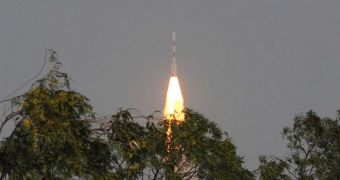The Mars Orbiter Mission (MOM), India's first foray into interplanetary space travel and studies, lifted off successfully from the Satish Dhawan Space Center, in Andhra Pradesh province, on November 5, at 09:08 UTC. Both the spacecraft and its carrier rocket are in perfect health.
The Indian Space Research Organization (ISRO) managed to set up and launch this mission for less than $70 million (51.8 million euros). MOM took off from SDSC's First Launch Pad (FLP), aboard a Polar Satellite Launch Vehicle (PSLV) heavy delivery system, India's most reliable large rocket.
All four stages of the PSLV functioned flawlessly, inserting the vehicle in an orbit measuring 248 by 23,500 kilometers (154 by 14,600 miles), which it will occupy for the next 20 to 25 days. A series of six orbital boost maneuvers will eventually send MOM on its nine month voyage to Mars.
Orbital insertion around the Red Planet is expected to occur on September 21, 2014, ISRO officials estimate, just a day before NASA's Mars Atmosphere and Volatile EvolutioN (MAVEN) orbiter. The latter will launch from Florida's Cape Canaveral Air Force Station on November 18.
MOM's primary mission will be to study the environment and atmosphere of Mars, to take pictures of the planet's surface, and to demonstrate that India masters the necessary technology to insert a satellite into orbit around another planet. ISRO experts say they will work with NASA colleagues when the two spacecraft's missions overlap.
The Indian spacecraft carries a total of five instruments, weighing about 15 kilograms (33 pounds). The Lyman-Alpha Photometer (LAP) and Methane Sensor For Mars (MSM) are designed to support atmospheric studies, while the Mars Color Camera (MCC) and Thermal Infrared Imaging Spectrometer (TIS) will study the surface.
MOM also carries the Mars Exospheric Neutral Composition Analyzer (MENCA) instrument, which was designed for advanced particle environment studies. MENCA will be focused on the Martian exopshere, and will provide data on how this atmospheric layer interacts with solar particles.
Given that countries such as Japan and China have thus far failed to put an orbiter around Mars, some analysts argue that India's successful launch of the MOM spacecraft represents the beginning of another space race, this time centered around Asia, DNA India reports.

 14 DAY TRIAL //
14 DAY TRIAL //